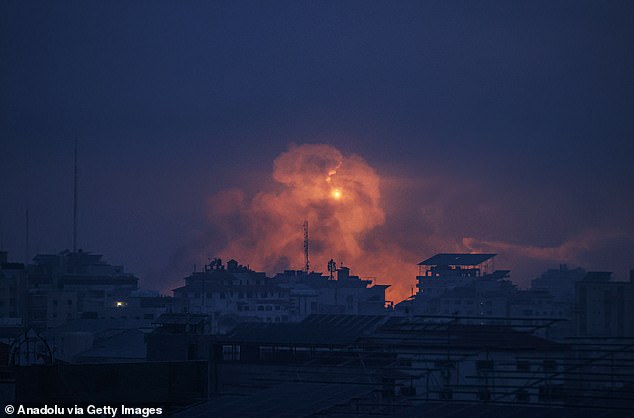To destroy Hamas headquarters, Israelis must go underground, says former IDF conscript RICHARD PATER
Street-to-street fighting, hidden explosives and Hamas terrorists hidden underground. This is the prospect that awaits the Israeli forces as their tanks and infantry enter Gaza.
The limited nature of their raids in recent days suggests that this is a much more carefully calibrated ground offensive than Hamas might have expected.
After the horrific barbarity of October 7, Israel could have sent thousands of troops across the border in an all-out invasion. But the more soldiers you deploy, the more there are for the terrorists to kill.
The Israeli Defense Force (IDF) knows that this campaign could last months.
A cautious approach on the ground makes it flexible in terms of the pace at which progress is made.
Smoke rises after the Israeli bombardment of the northern Gaza Strip on Sunday
Besides the all-important goal of safely returning the innocent men, women and children captured by Hamas, this is why we have seen the IDF deploy far fewer infantry than expected in what appears to be a tactical pincer movement.
Israeli Prime Minister Benjamin Netanyahu has described the latest operation as the “second phase of the war.”
The IDF has already crossed the first few hundred meters of the Gaza Strip – the open fields that favor tanks and heavy artillery.
Hamas has likely prepared traps in this area, including improvised explosive devices (IEDs).
But when I served as a conscript in the IDF in 2000-2001 – as is mandatory for Israeli citizens – we had the best mine detection technology available, so I doubt this will be a strategic obstacle.
We also relied on Bedouin trackers, experts at detecting disturbances on the desert floor that could be a buried IED.
This expertise allowed the IDF to enter Gaza at two points. One is located at Beit Hanoun in the northeast of the Strip, the other further away at Bureij. By encouraging all civilians to flee to safer areas in the south, the IDF aims to encircle and trap Hamas forces – and then lure them out. Not with the door-to-door, street-by-street fighting that Hamas terrorists – and many military experts as well – might have expected, but with strategic cunning.

A huge fireball is seen rising over Gaza City after intense Israeli attacks
The Israeli army has enlisted its “best soldiers and commanders” – the smartest recruits who can make their own decisions on the ground.
That could well take them underground – because of the estimated 500 kilometer tunnel network that Hamas has built under Gaza.
Tunnel war is inevitable. According to some reports, the Israeli Air Force deployed ‘bunker buster’ munitions to destroy Hamas’ tunnel network. These advanced missiles have two warheads: the first creates a hole, the second penetrates deeper into the earth and destroys underground structures. Tunnel mapping robots will also be used to plant explosives.
However, sometimes it will be necessary for combat engineers to descend into the unknown.
They have some of the most advanced military technology in the world. This also includes ‘sponge bombs’ that use a chemical reaction to create a hardening foam that can seal Hamas’ tunnel openings.
Although the IDF has the upper hand in the skies over Gaza, it still faces the threat of drones.
Three weeks ago, Hamas’s breakthrough into Israel was aided by dozens of unmanned aerial vehicles – some spying on the ground for their terrorists, others carrying explosives. But we know that an air convoy from the United States has already delivered weapons believed to include advanced Stinger missiles fired from shoulder launchers and which have been used in Ukraine to combat Russian-controlled drones and other aerial attacks .
Israel has also invested in the Merkava Barak tank, which has sensors that can detect when an enemy system is engaged so it can shoot down incoming missiles.
With the enemy below them, snipers and drones above them, and tripwires and IEDs at their feet, one of the IDF’s objectives will be to reach Al-Shifa Hospital in central Gaza City, presumably on top of the underground nerve center of Hamas. .
The base is believed to consist of war rooms used as headquarters for the terrorist group, as well as fuel supplies.
This is the head of the snake, and if the IDF can cut it off it would be a huge step towards victory in the region.
The discovery of Hamas’s underground hideout would also be a propaganda coup for Israel, exposing the terror group’s disregard for human life, using the sick and injured as cover from the air.
For Hamas, victory will come from endurance. It should take longer than Israeli politicians and the Israeli people can bear, which could take years.
No matter how long it takes, a massive invasion of the Gaza Strip remains an unlikely option in my opinion. Israel has already called up 360,000 of its reservists, but they are needed elsewhere, not least in the north of the country, where Hezbollah could escalate attacks along the border into all-out war.
So while these Israeli reservists may not be sent to the Gaza Strip anytime soon, it would be unwise for Hamas to view the relatively modest number of Israeli soldiers on the ground as a sign of weakness.
With strategic precision and the IDF’s formidable war chest, this powerful force could successfully strike the heart of Hamas.
Richard Pater is the Jerusalem-based director of Bicom, a British-Israeli think tank, and served in Gaza with the IDF.
